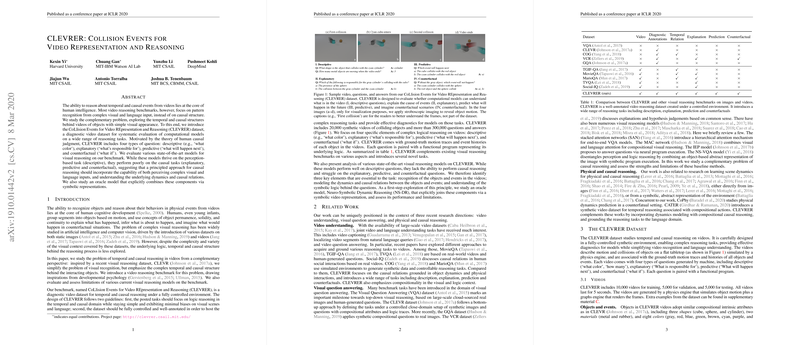Exploring Temporal and Causal Reasoning in CLEVRER
This essay reviews the paper "CLEVRER: Collision Events for Video Representation and Reasoning," which introduces the CLEVRER dataset designed to enhance the evaluation of computational models concerning temporal and causal reasoning in videos. The dataset focuses on exploring video content that emphasizes event causality and temporal progression rather than static pattern recognition relying solely on complex visual input. This paper addresses a critical gap in current video reasoning benchmarks by focusing on causal analysis and reasoning, essential components for advancing artificial intelligence models.
CLEVRER, an acronym that stands for Collision Events for Video Representation and Reasoning, contains 20,000 synthetic videos showcasing object interactions through collisions. Each video is annotated with over 300,000 questions divided into four primary categories: descriptive, explanatory, predictive, and counterfactual. The questions are conceptually designed to test a model's prowess in carrying out tasks such as recognizing and describing object attributes, explaining causal relationships, anticipating future events, and considering hypothetical scenarios.
The CLEVRER dataset distinguishes itself by providing a controlled environment for evaluating video reasoning models. The dataset's comprehensive structure, characterized by ground-truth motion traces and event histories, assists in understanding objects' dynamics and interactions. More importantly, the dataset's diagnostic nature allows for effective model evaluation, emphasizing cognitive tasks rarely addressed in existing benchmarks.
The authors conducted a range of experiments on this dataset using various state-of-the-art video reasoning architectures. Interestingly, while existing models excel in descriptive tasks, they fall short for tasks requiring more sophisticated causal reasoning. These results are significant as they point out the inadequacies in current architectural designs and inform future research directions.
To counter the deficits highlighted in these experiments, the authors present a novel model, the Neuro-Symbolic Dynamic Reasoning (NS-DR) framework, which integrates symbolic logic representations with a neural dynamics predictor. This dual approach couples visual perception and temporal event modeling, offering more comprehensive reasoning capabilities by effectively parsing visual, temporal, and causal contexts simultaneously. The NS-DR model utilizes a symbolic representation to negotiate between visual and language information, combined with a neural network-based physics engine to predict event outcomes. Results show that the model performs notably well on the descriptive tasks and achieves higher accuracy on predictive and counterfactual questions, suggesting the importance of dynamics modeling for enhanced reasoning.
CLEVRER's implications extend to both theoretical and practical domains. Theoretically, the dataset reinforces the importance of object-centric and dynamic process modeling, essential for developing causally intelligent systems capable of understanding and manipulating real-world environments. Practically, models trained on CLEVRER datasets could impact real-world scenarios such as robotic motion planning and autonomous systems, where understanding causal dynamics is critical to performance. Evaluation on CLEVRER encourages a paradigm shift focusing on integrating dynamic and causal knowledge with pattern recognition.
Future research directions could involve developing models with enhanced capabilities in causal inference, leveraging symbolic representation and neural dynamics. Incorporating weakly-supervised learning to disentangle perception and reasoning could also bridge the gap between real-world applicability and controlled environment performance.
The value of CLEVRER goes beyond benchmarking; it sets the stage for aspiring towards models capable of human-like reasoning by focusing on temporal and causal dynamics. This alignment of AI development builds toward a future where models don't just see but truly comprehend and reason.
